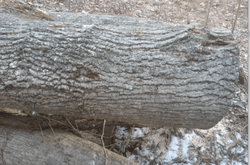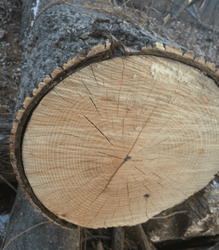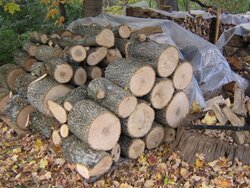Is this Ash?
- Thread starter Razo
- Start date
-
Active since 1995, Hearth.com is THE place on the internet for free information and advice about wood stoves, pellet stoves and other energy saving equipment.
We strive to provide opinions, articles, discussions and history related to Hearth Products and in a more general sense, energy issues.
We promote the EFFICIENT, RESPONSIBLE, CLEAN and SAFE use of all fuels, whether renewable or fossil.
You are using an out of date browser. It may not display this or other websites correctly.
You should upgrade or use an alternative browser.
You should upgrade or use an alternative browser.
- Status
- Not open for further replies.
Applesister
Minister of Fire
The end of the log looks very Ashy. Your picture isnt clear but I can still see growth rings very easily.
The bark is tougher, I dont see the "diamonds" that the peaks of the ridges form that would make it a classic ID. Knowing that bark is variable I would say possibly White Ash.
But not 100% sure.
Its not poplar or any of the lighter woods, so its probably a safe time investment.
The bark is tougher, I dont see the "diamonds" that the peaks of the ridges form that would make it a classic ID. Knowing that bark is variable I would say possibly White Ash.
But not 100% sure.
Its not poplar or any of the lighter woods, so its probably a safe time investment.
Soundchasm
Minister of Fire
Thanks for the input, what do you mean by the following:
I'm not familiar with what you are referring to but would love to find out if it would help me better identify ash in the future
see evidence of the EAB, then it's confirmed. D shaped holes or pull up the bark.
I'm not familiar with what you are referring to but would love to find out if it would help me better identify ash in the future
Backwoods Savage
Minister of Fire
Razo, rest in peace. You have some ash there.
What Soundchasm was relating to is the hole in the bark that the EAB makes. That hole will be shaped like a D. Just picture that D in the tree and there will be several of them show at eye level and below. Then after felling the tree you'll also find more holes in the limbs.
Here is a picture of an EAB. There is one hold down and to the left of the borer in the picture.
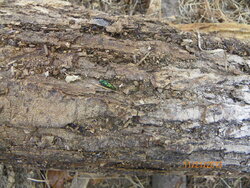
One good thing is that you need not rush to get the wood as ash will last for years and years. We got the borer in 2002 and are still cutting dead trees. So far we've had only 2 trees fall but the rest are still standing or are in our wood piles right now. Well, some is also in our stove now.
What Soundchasm was relating to is the hole in the bark that the EAB makes. That hole will be shaped like a D. Just picture that D in the tree and there will be several of them show at eye level and below. Then after felling the tree you'll also find more holes in the limbs.
Here is a picture of an EAB. There is one hold down and to the left of the borer in the picture.

One good thing is that you need not rush to get the wood as ash will last for years and years. We got the borer in 2002 and are still cutting dead trees. So far we've had only 2 trees fall but the rest are still standing or are in our wood piles right now. Well, some is also in our stove now.
Paulywalnut
Minister of Fire
The little BB size hole right in the middle at the end of each cut piece. Dead give away Nice wood.
Nice wood.
 Nice wood.
Nice wood.nrford
Minister of Fire
Applesister
Minister of Fire
Emerald Ash Borer
It looks like a elongated wad of aluminum foil with lime green paint sprayed over it.
It is one of many metallic colored wood borers. It was traced to a shipping dock on Lake Michigan where it was introduced.
It is a wood eating bug with a devasting appetite for Native Ash trees. The bug is wiping the trees out as it spreads across the country.
It looks like a elongated wad of aluminum foil with lime green paint sprayed over it.
It is one of many metallic colored wood borers. It was traced to a shipping dock on Lake Michigan where it was introduced.
It is a wood eating bug with a devasting appetite for Native Ash trees. The bug is wiping the trees out as it spreads across the country.
husky345 vermont resolute
Feeling the Heat
Sure is ash. White ash. Some of the best wood around. It seasons fairly quick due to its low moisture content
BEConklin
Feeling the Heat
Here's a picture of a "D shaped exit hole" made by an emerald ash borer.

The adult lays eggs in the crevices on the bark, the eggs hatch and bore tiny holes through the bark into the layer just beneath the bark, then they eat criss crossing back and forth under the bark. The next stage, they bore into the wood, pupate, then bore their way back out of the tree as an adult to fly off and mate. They leave that distinctive D shaped hole when they emerge from the tree as adults.

The adult lays eggs in the crevices on the bark, the eggs hatch and bore tiny holes through the bark into the layer just beneath the bark, then they eat criss crossing back and forth under the bark. The next stage, they bore into the wood, pupate, then bore their way back out of the tree as an adult to fly off and mate. They leave that distinctive D shaped hole when they emerge from the tree as adults.
Woody Stover
Minister of Fire
Yeah, the split grain is very distinctive, rougher than, say, Maple, and can have more of a yellow cast to it (that might just be the dead standing.) White Ash is great firewood, with heat output almost that of Red Oak. Better than Green or Black Ash.Thanks for the opinion, I felt the same about the bark, I can kick myself for not at least grabbing a round to split to get a better look at the grain. Glad to know its not one of the softer hardwoods.
If you see evidence of the EAB, then it's confirmed. D shaped holes or pull up the bark.
If you are able to identify the trees by the holes, kiss your Ash goodbye; It's just a question of time before they're all gone. I haven't seen the holes yet, but it won't be long here.I'm not familiar with what you are referring to but would love to find out if it would help me better identify ash in the future
 What does the "D" stand for, "dumb" for importing me?
What does the "D" stand for, "dumb" for importing me? 
Last edited:
Backwoods Savage
Minister of Fire
Emerald Ash Borer
It looks like a elongated wad of aluminum foil with lime green paint sprayed over it.
It is one of many metallic colored wood borers. It was traced to a shipping dock on Lake Michigan where it was introduced.
It is a wood eating bug with a devasting appetite for Native Ash trees. The bug is wiping the trees out as it spreads across the country.
The first picture is one I took when we found this in one of our wood piles.
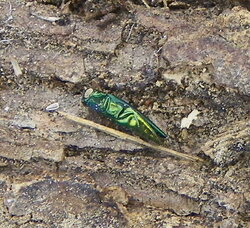
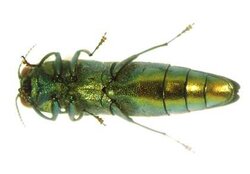
Woody Stover
Minister of Fire
If they're not there yet, it won't be long.I hope they have not made their way to the woods of Pennsylvania yet.

BEConklin
Feeling the Heat
EAB is not in my part of CT yet, according to the DEP....but I took an ash down in my yard last month and there were D holes in it..the branches were dying off as well.
Backwoods Savage
Minister of Fire
The first thing we noticed here (other than the holes) seemed to be the flaking of the bark. Then the trees would also send out new suckers mostly near the bottom of the tree. Once you see those, the tree is basically history.
- Status
- Not open for further replies.
Similar threads
- Replies
- 7
- Views
- 1K
- Replies
- 7
- Views
- 522


